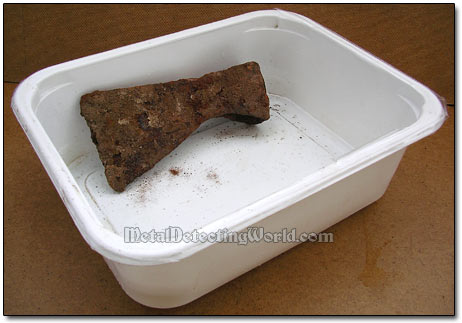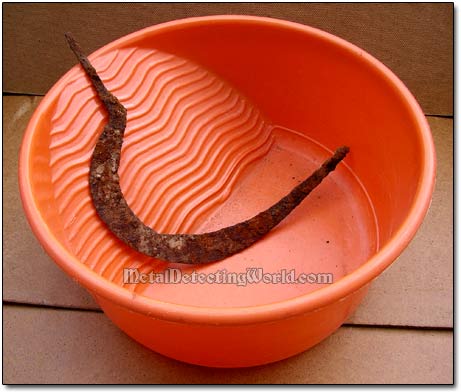Rust Removal with Electrolysis - Detailed Illustrated Tutorial, page 14
2. How To Make a Simple Electrolysis Device: a Non-Conductive Container for Electrolysis Machine
5) Non-Conductive Container for Electrolysis Machine
A wide variety of inert and non-conductive containers of various caustic and acid-resistant plastics, such as polyvinyl chloride (PVC), polypropylene (PP), and polyethylene (PE), can be used in an electrolytic setup. Plastic containers can be of any size depending on sizes of iron artifacts to be de-rusted: one gallon ice cream container, a five gallon bucket, or a fifty-five gallon barrel.
However, there are a few important things to consider when you choose the size of the container for your electrolysis machine:
1) Your iron object obviously has to fit into the container.
2) The iron object should be surrounded by anodes for faster and efficient rust removal.
3) When one or two anodes are used in a setup, the current flowing through electrolyte should have enough room for forming a dynamic and encompassing "field", so all sides of the iron object are getting derusted simultaneously. A large container allows the surrounding field of voltage to develop. If there is a large space around the anode, the back side of it becomes electrically active and "connects" to the solution. The same effect occurs at the iron object.
To sum everything up, the larger the container, the better!
In this tutorial, I used two plastic containers. One is of a medium size, which I used for the sake of taking a good picture of my electrolytic setup.
Medium Plastic Container for Electrolysis

When I began using electrolysis for removing rust, I started with a small container that was just enough to fit an iron object I had to clean. As I was gaining more experience with electrolysis, I gradually moved up to a 3-gallon (12 liters) container that could fit into an available space at home.
I Use This Plastic Washing Basin for All My Electrolytic Rust Removal Projects

Besides the non-conducting containers, conducting mild steel vats in combination with auxiliary anodes to assure a more even distribution of current are frequently used in electrolytic de-rusting. I would strongly CAUTION anyone against using the metallic containers (especially galvanized ones introducing zinc into the electrolyte) as anodes in electrolysis because of:
1) a high risk of being electrocuted,
2) a high probability of shirt-circuiting,
3) a huge mess that can happen when the anode-container disintegrates, and the gross-looking electrolyte (the solution will get loaded with the loosened rust, gunk, bubbling crud, and all sorts of contaminants) is spilled through the holes and perforations in the container!
Metal containers have a big advantage over plastic ones only when very large iron objects get de-rusted (by professional marine archaeologists for example), where it is not economically feasible to have different vats for electrolysis, rinsing, dehydration, and wax impregnation.
One of many advantages of the plastic containers is that the non-conductive containers of various shapes can be easily homemade. For example, PVC plastic pipes with sealed ends make excellent vats for de-rusting the long and slim artifacts such as rifle barrels. Glass containers are also suitable for electrolytic setups.
NOTE: When electrolysis is done outdoors (I would not recommend to do it indoors!), for example, in your backyard, the container with electrolyte should be covered, but NOT completely with a tight lid (not recommended!), to keep leaves, branches, pets and small kids out of it! And to prevent accidental moving of both iron parts and electrodes by wind gusts.